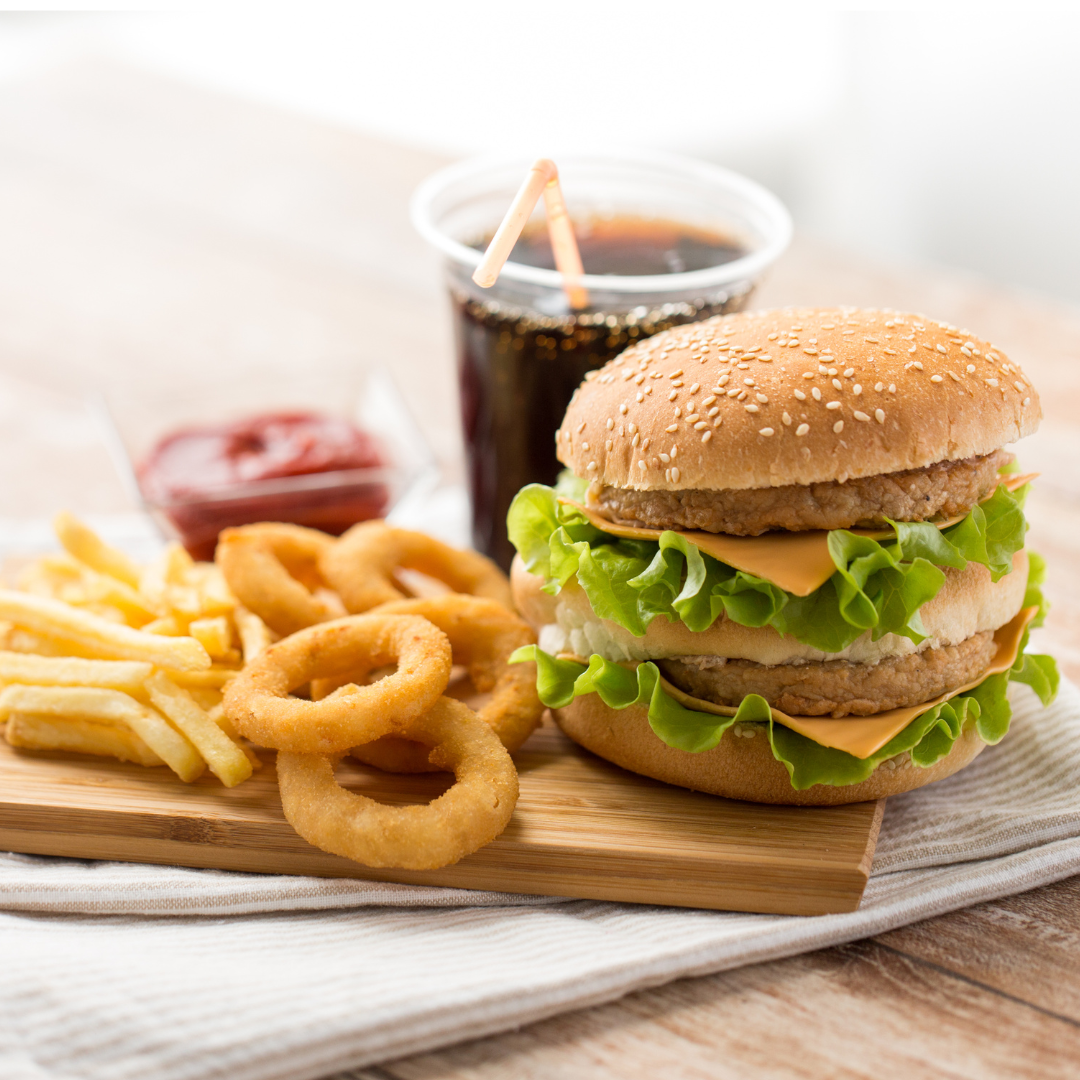Ultra processed food – not quite so convenient
Ultra-processed foods (UPFs) have become the backbone of the modern Western diet. They are convenient, cheap, and often delicious but emerging evidence suggests they may be quietly eroding men’s reproductive health. A wave of new studies, including a 2025 clinical trial published in Cell Metabolism by Preston et al. (2025) is painting a clearer picture: diets high in UPFs may disrupt hormones, damage sperm at the molecular level, and impair the very process by which sperm are made. A further study by Soubry et al. (2021) found that eating fries regularly may affect sperm health by causing changes in DNA that could be passed on to children. These changes might increase the risk of certain long-term health problems in the next generation. In contrast, the reduction of UPFs and rather having a Mediterranean diet may improve semen parameters. Nevertheless, these studies also highlight that these results need to be replicated in properly designed epidemiological studies.
What counts as “Ultra‑Processed”?
Not all processed food is bad but UPFs are in a category all of their own. Using the NOVA classification system, foods are divided into four groups based on how much they are altered:
- Unprocessed or minimally processed: Whole fruits, vegetables, plain rice, fresh fish, raw nuts.
- Processed: Simple breads, cheese, canned beans, smoked meats.
- Culinary ingredients: Oils, butter, sugar, salt.
- Ultra‑processed: Industrially manufactured products with long ingredient lists such as sodas, packaged snacks, instant noodles, reconstituted meat products, frozen ready meals, and even many “diet” or “health” foods.
UPFs are engineered for maximum palatability, shelf‑life, convenience and profitability. UPFs aren’t really foods; they are mass produced products made to look like food! They often contain additives, colourings, emulsifiers, sweeteners, and many other ingredients that you wouldn’t find in your kitchen such as protein isolates, modified starches and hydrogenated oils.
How we got here: The rise of UPFs
The first wave of UPFs emerged in the early‑mid 20th century with the rise of industrial food production. Wartime rationing, advances in food preservation, and the boom in industrial agriculture after World War II drove the creation of cheap, shelf‑stable staples: white bread, canned soups, processed meats. By the 1970s and 80s, convenience foods and ready meals were marketed aggressively to busy households, coinciding with more women entering the workforce and less time spent cooking. The 1990s and 2000s saw an explosion of snack foods, sugary beverages, and “diet” or “lite” products that were lower in fat but often higher in sugar.
During the same decades, rates of obesity, type 2 diabetes, and cardiovascular disease began to climb dramatically a trend well‑documented in public health data. Between 1975 and today, global obesity rates have nearly tripled. Male infertility has also risen, with some studies reporting a 50%decline in sperm counts since the 1970s. While multiple factors contribute such as sedentary lifestyles and environmental exposures the parallel rise of UPF consumption and chronic disease has led researchers to suspect a strong link.
Today, more than 50–60% of calories in the average UK or US diet come from UPFs, with some surveys finding levels as high as 70%among adolescents. Similar patterns are now seen in Europe, Australia, and rapidly urbanising parts of Asia and South America.
How UPFs affect the body and the testes
The study by Preston et al. (2025) placed healthy young men on two tightly controlled diets one dominated by UPFs, one made of unprocessed foods while keeping calories, protein, fat, and carbs constant. The results were striking:
- Men gained fat mass on the UPF diet despite eating the same calories.
- LDL cholesterol rose, and hormone patterns shifted notably a decrease in follicle‑stimulating hormone (FSH), a key driver of sperm production.
- Levels of phthalate metabolites, chemicals linked to endocrine disruption increased during the UPF phase.
These findings suggest that UPFs harm metabolic health and interfere with the hormonal environment that regulates spermatogenesis.
The biology of Spermatogenesis — and where UPFs interfere
Spermatogenesis is a continuous process of production of sperm inside the seminiferous tubules of the testes. This process takes about 74days and relies on a delicate interplay of hormones:
- GnRH from the hypothalamus triggers LH and FSH release from the pituitary.
- LH stimulates Leydig cells to make testosterone; FSH acts on Sertoli cells to nurture developing sperm.
- Adequate micronutrients (zinc, selenium, folate), antioxidants, and energy balance are essential to support DNA packaging and maturation.
UPFs may disrupt this system in several ways:
- Hormonal disruption: Lower FSH or altered testosterone:estrogen ratio can reduce sperm count and quality.
- Oxidative stress: Diets high in refined carbs and poor quality fats can increase reactive oxygen species, which attack sperm membranes and fragment DNA, an effect linked to lower motility and higher miscarriage risk.
- Nutrient displacement: When UPFs replace nutrient dense foods, men may miss critical micronutrients that protect sperm from damage.
- Endocrine disrupting chemicals: Packaging and processing canintroduce endocrine disrupting substances such as phthalates and bisphenolsinto the food. These substances mimic hormones, interfering with testicular function.
The mechanisms of physiological disturbance
Scientists are beginning to uncover how UPFs may create these changes at a cellular level:
- Gut microbiome disruption: Emulsifiers and refined ingredients can alter gut bacteria composition, reduce microbial diversity, and increase intestinal permeability (“leaky gut”). This allows bacterial toxins such as lipopolysaccharides (LPS) to enter the bloodstream.
- Chronic low‑grade inflammation: Circulating LPS triggers the immune system, leading to production of cytokines (TNF‑α, IL‑6) that can impair insulin sensitivity and disrupt the hypothalamic–pituitary–gonadal axis, which controls reproductive hormones.
- Oxidative stress and AGEs: High heat processing and sugar content lead to advanced glycation end-products (AGEs), which generate free radicals. These damage cellular membranes and DNA, including within sperm and Sertoli cells.
- Leydig and Sertoli cell stress: Inflammation and oxidative stress reduce the testosterone production of Leydig cell and impair the ability of Sertoli cells to nourish developing sperm, leading to lower quality and motility.
In other words, UPFs are not just passive calories, they can shift the body’s immune and hormonal environment, creating a less hospitable setting for healthy sperm production.
Beyond calories: Why this matters for fertility
The Italian study by Ceretti et al. (2024) found that men who ate the most UPFs had significantly lower sperm concentration and progressive motility than those who ate the least, even after adjusting for lifestyle factors like BMI and smoking. Combined with the metabolic data, the message is clear: UPFs affect more than weight, they may compromise male fertility at the molecular and hormonal level.
The myth of the “Healthy” UPF
Many products wear a health halo “low fat,” “high protein,” “plant‑based,” “gluten‑free” but remain ultra‑processed. Flavoured yogurts, energy bars, diet sodas, and plant‑based meat substitutes often contain multiple additives and refined ingredients that contribute little nutritionally and may still carry the risks described above.
Realistic and practical steps
Cutting out UPFs entirely is unrealistic for most people, they are so ingrained in society and our food chain, near on impossible to avoid. But reducing them even modestly can improve metabolic and reproductive health.
- Cook more at home: Focus on simple meals built from whole foods.
- Read ingredient lists: Shorter is usually better.
- Swap smartly: Replace flavoured yogurt with plain yogurt + fruit, choose whole‑grain bread with minimal ingredients, swap processed meat for fresh.
- Avoid heating food in plastic containers: This reduces chemical exposure.
- Support antioxidants: Eat colourful fruits, vegetables, and nuts to buffer oxidative stress.
- Think long‑term: Since spermatogenesis takes about three months, dietary changes today will pay off 3 months down the road but it’s a continuous process.
- Aim for progress, not perfection: Reducing UPF intake from 60% to 40% of calories can already yield measurable metabolic improvements.
Bottom line
Ultra‑processed foods are not just an issue of empty calories. Evidence suggests they may undermine male fertility by shifting hormones, increasing oxidative stress, and introducing chemical disruptors even without overeating. While eliminating them completely may not be practical, a conscious effort to limit UPF intake and favour whole foods could protect both your waistline and your future fertility. Including just a few more unprocessed meals per week may be enough to tip the balance toward better sperm health and better overall health.
Research
- Preston JM, Iversen J, Hufnagel A, Hjort L, Taylor J, Sanchez C, George V, Hansen AN, Ängquist L, Hermann S, Craig JM, Torekov S, Lindh C, Hougaard KS, Nóbrega MA, Simpson SJ, Barrès R (2025); Effect of ultra-processed food consumption on male reproductive and metabolic health. Cell Metab 22: S1550-4131(25)00360-2
- Ceretti E, Bonaccio M, Iacoviello L, Di Castelnuovo A, Ruggiero E, Donato F, Lorenzetti S, Zani D, Montano L (2024); Consumption of ultra-processed foods and semen quality in healthy young men living in Italy. Nutrients 16 (23): 4129
- Monteiro CA, Cannon G, Lawrence M, Costa Louzada ML, Machado P P (2019); Ultra-processed foods, diet quality, and health using the NOVA classification system. FAO. https://www.fao.org/3/ca5644en/ca5644en.pdf
- Hall KD, Ayuketah A, Brychta R, Cai H, Cassimatis T, Chen KY, Chung ST, Costa E, Courville A, Darcey V, Fletcher LA, Forde CG, Gharib AM, Guo J, Howard R, Joseph PV, McGehee S, Ouwerkerk R, Raisinger K, Rozga I, Stagliano M, Walter M, Walter PJ, Yang S, Zhou M (2019); Ultra-processed diets cause excess calorie intake and weight gain: An inpatient randomized controlled trial of ad libitum food intake. Cell Metab 30(1): 67-77
- Chassaing B, Koren O, Goodrich JK, Poole AC, Srinivasan S, Ley RE, Gewirtz AT (2015); Dietary emulsifiers impact the mouse gut microbiota promoting colitis and metabolic syndrome. Nature 519(7541): 92-96
- Aitken RJ, Drevet JR (2020); The importance of oxidative stress in determining the functionality of mammalian spermatozoa: A two-edged sword. Antioxidants (Basel) 9: 111
- Valle-Hita C, Salas-Huetos A, Fernández de la Puente M, Ángeles Martínez M, Canudas S, Palau-Galindo A, Mestres C, Manzanares JM, Murphy MM, Marquès M, Salas-Salvadó J, Babio N (2024); Ultra-processed food consumption and semen quality parameters in the Led-Fertyl study. Hum Reprod Open 2024(1):hoae001
- Soltani M, Ahmadi MR, Shateri Z, Maghsoudi Z, Rajabzadeh-Dehkordi M, Askarpour M, Asadi AH, Nouri M (2025); The association between consumption of ultra-processed foods and sperm quality parameters: a cross-sectional study. BMC Res Notes 18(1): 48
- Soubry A, Murphy SK, Vansant G, He Y, Price TM, Hoyo C (2021); Opposing epigenetic signatures in human sperm by intake of fast food versus healthy food. Front Endocrinol (Lausanne) 12: 625204
- Petre GC, Francini-Pesenti F, De Toni L, Di Nisio A, Mingardi A, Cosci I, Passerin N, Ferlin A, Garolla A (2025); Role of mediterranean diet and ultra-processed foods on sperm parameters: Data from a cross-sectional study. Nutrients 17(13): 2066
- Pecora G, Sciarra F, Gangitano E, Venneri MA (2023); How food choices impact on male fertility. Curr Nutr Rep 12(4): 864-876
















.png)

